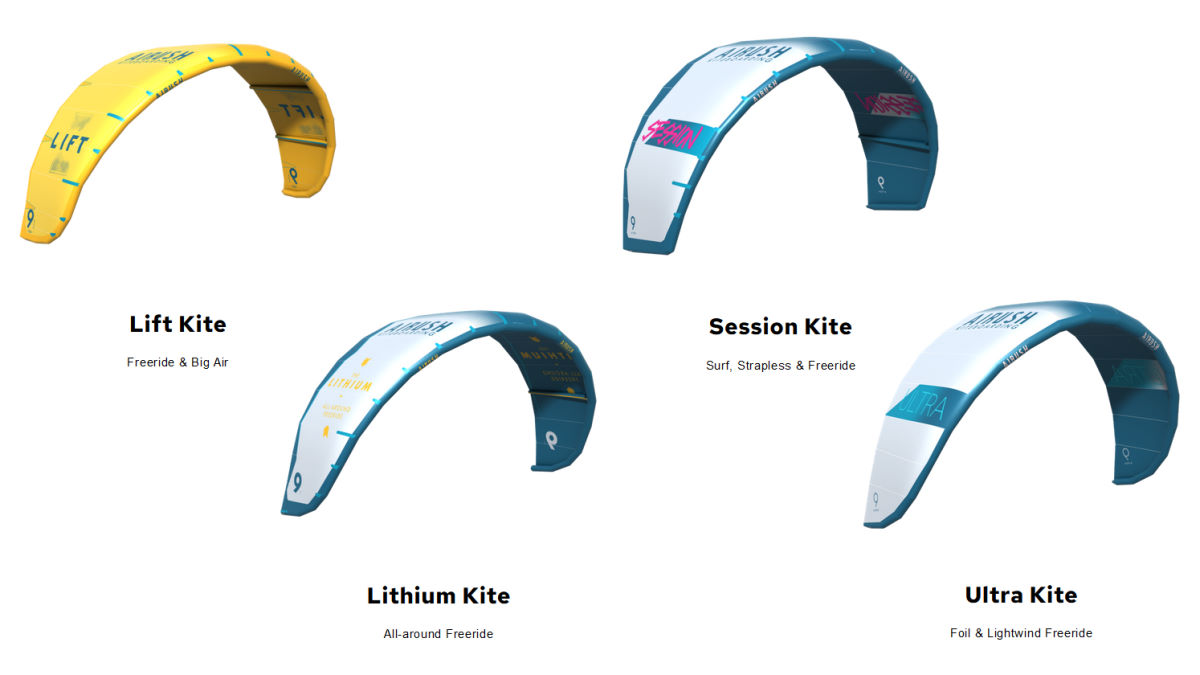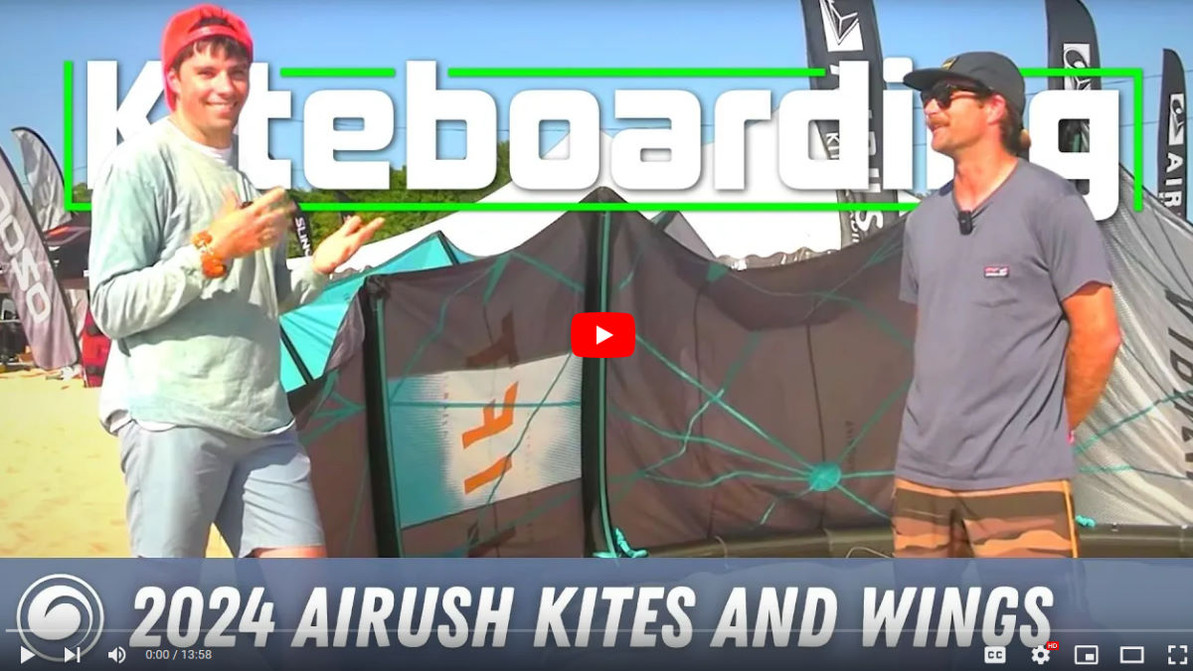Airush's Latest Innovations | An Exclusive Interview with Sam Medysky
Jake Mitchell from MACkite is with Sam Medysky of Airush at the 2023 King of the Great Lakes Test Fest. Sam's been a name in the kiteboarding world for many years and has some insights into the Airush lineup and wind sports in general to share.
Jake: We've got the man, the myth, the legend, Sam with Airush here. Sam, how long have you been working with Airush?
Sam: I've been with Airush since 2017. I've been kiting since 1998, 25 years, and I've been coming to this event since 2004. I still have the t-shirt from this event when it was a competition.
Jake: That's awesome! What was your first kite back in the day?
Sam: The very first kite we had was a Wipika Classic 8.5 meter two-line kite, and then we also had Flexifoil Blades and we had the Concept Air Traction EX. My first time ever riding on a board was on a big, directional windsurf board. We converted the footstraps to work as a kiteboard, and I was controlling the kite with handles with a rope in between that I hooked into. When you'd twist the handles down, that was the brake on the kite.
Jake: Oh yeah, I remember those four-line kites. Do you still have those or are they long gone?
Sam: Oh, they're long gone, yeah.
Jake: Well, fortunately we've come a little way since those days, and we've got the all-new Airush Lift behind us.
Sam: Yeah, this is the Lift Team. We simplified the Airush range this year. We have four main models: the Ultra, the Lithium, the Session and the Lift. All of our kites are now available in two constructions: our original construction, which is your regular Dacron and regular dual ripstop canopy material, and our Team Construction, which features the Ho'okipa leading edge, which is an Ultra woven PE material with a laminate on one side, and it also features our Load Frame, which is the blue stitching on the inside of the kite. That's also Ultra PE that's sewn into the kite, and that helps keep the shape of the kite so you get more longevity out of your sail, and if you do rip your kite, it won't rip as far.
Jake: That's interesting. And you source your fabric from a factory called Challenge?
Sam: Yeah, Challenge is a U.S.-based company. Within the kiteboarding and wing world, they probably make at least 50 percent of the canopy, strut and leading edge materials for all the manufacturers. Loads of manufacturers use Challenge products, and we're one of them. On the Lift Team we use the Ho'okipa, which is from Challenge, and that's something that we worked on with them for many years. I think one cool thing that you see in the industry right now is that there's a lot of development, not only with wings and kites, but we're also starting to bring in new materials that we haven't seen in the past. We've been using Dacron for so many years, and it's an excellent material, but now we're trying to reach a bit further to try to use and incorporate new materials to get better quality products that last longer and get more performance out of those products.
Jake: So if somebody's trying to decide which direction to go, regular Dacron versus the Team Construction, what do you tell them?
Sam: Obviously, our Team Construction is going to be a bit more expensive. There's more that goes into those products in the cost of raw materials and putting the Load Frame on the kite. So that increases the end price of the kite or the wing. But what you're going to get with the Ho'okipa on the leading edge is a narrower diameter because we can put a higher PSI in the Ho'okipa material than a traditional Dacron. With a narrower leading edge, not only are you getting a weight reduction with the Ho'okipa material itself being 25 percent lighter, but you're also using less material. Since you're able to pump them harder, you have a really rigid airframe and a lot of forward drive with that narrower diameter leading edge.
The Load Frame prevents the kite from stretching so that it keeps that same pocket and that same power, so you get more life out of your kite, and if it rips, it can't rip top-to-bottom because that Load Frame will stop it. So for repairs it's going to be a smaller, cheaper repair.
Jake: What about repairability? That's been one of the issues with Aluula, and it's being addressed, but is this just as easy to fix as a regular Dacron?
Sam: The nice thing with Ho'okipa is that it's still a woven material versus a full laminate, so yeah, it's great because it is really easy to repair. We've had comments from repair centers like Airtime that it's nice to work with versus some of the laminates out there. I'm not knocking them because they are great products for sure, but they are more challenging to repair and to do seam work on in the factory.
Jake: Let's take an overview of the line. We have the Lift- who is this kite for? It's been featured the Blank Kite Test and placed quite favorably, which is awesome.
Sam: The Lift is our 5-strut dedicated performance freeride kite. Everything crosses over a little bit, but this is for the rider that wants to do it all. It's an incredible big air kite. Having the 5-strut design, it's got tons of forward drive and it's really stable in strong conditions, but it's also awesome for unhooking. So it's a little bit of a do-it-all kite, but for somebody who's looking to do big jumps, big loops and ride in overpowered conditions, I would send them towards the Lift.
The next one in our range, which is also in that freeride category, would be the Lithium. The Lithium is a 3-strut kite. It's got swept back wingtips, so it's an easy kite to ride. You can go from your first waterstarts on that kite to boosting huge airs and whatnot. It's actually been our top seller the past couple years. It's just a fun, easy kite, kind of like your daily driver.
The Session V2 has just come out. It's our dedicated freeride wave kite, so it's excellent in the waves, drifts really well, and also works really well for foiling. If somebody's riding waves a lot and they like to foil on lighter wind, I would send them towards the Session.
We've had the Ultra in the range for as long as foiling's been around, and that's our dedicated one-strut kite, which has done really well for us over the past few years with foiling. We've redesigned that for 2024. We changed the wingtip shape on it and we made it a little lower aspect to sit a bit deeper in the wind window. So far, the feedback's been really good on the new Ultra.

Again, all four of those kites in the range are available in the original construction as well as in our Team Construction.
Jake: How about color options?
Sam: In the original construction, we have most models in three different colorways, and then our Team Construction kites only come in one colorway so it's quite defined. If you see an Airush kite out there and it's this slate and gray, then that's our Team Series.
Jake: That's a nice callout. What does your personal quiver look like?
Sam: In my personal quiver, I've got a mixture because, like you, I've got a wife now, so I've gotta make sure I've got kites for her and kites for me, with wings mixed in. I have a Lift 12m and a 14 meter Ultra for really light wind. Yesterday, I was able to get out in the water here in 6-8 knots foiling on the 14 meter Ultra. Once I get into the smaller sizes, which my wife rides a lot, I've got a 7 and 9m Lithium. Any smaller than that, and you'll usually find me on my wings. That's when I switch to wing foiling.
Jake: And winging vs. kiting?
Sam: 50/50. Like I said, I've been kiting 25 years, and I still get enjoyment out of going out kiting because I get to pick a different vehicle every time I go kiting. Am I going to ride a surfboard? Am I going to ride a foilboard? Twintip with footstraps? Twintip with boots? I like it because it's different every time I go out on the water. I'm never bored.
And then the wing's awesome because I'm still learning all the time, and I think that's what attracts a lot of people to these sports. It's a constant progression. A lot of people start out riding a twintip and doing big jumps, and then they start to get a little bored or they plateau and they decide to pick up a surfboard and learn how to tack and jibe, maybe do some strapless airs. Then the same thing happens there and they get into foil and extend their rideable winds. Then the next thing is wing foiling. It's just the evolution of these sports. If you look at windsurfing, it led to kiting and kiting led to winging. This crazy wind sports community that we're in is a beautiful thing to see how it grows.
You can talk to some of the old windsurfers in our company like Sven, the owner. He competed in the Olympics back in the 80s in windsurfing. He's seen the start of windsurfing, he's seen the start of kiteboarding, and now the start of winging. It's really incredible how, within a short 50 years, how much wind sports have evolved.
Jake: So what's next?
Sam: I don't know. Talking with a few people here, it sounds like the downwind SUP paddling is quite big. But I feel like we're going have some sort of contraption where it's like an umbrella or some kind of Batman gizmo that you pop out, it gets you up on the foil, and then it tucks away quickly. Winging's beautiful in the waves and whatnot, but you still have a wing and it's still in the way sometimes.
Jake: I think it's actually kind of a dope idea. Maybe in the 2025 Airush catalog?
Sam: Umbrellas. Yes.
Jake: Sam, it's been a pleasure. I think, outside of Steve, you are the OG here. Thank you so much.
MACkite Subscription Links:
YouTube | Instagram | Spotify Oddcasts
Contact MACkite Below:
800.622.4655 | Kiteboarder@MACkite.com | LIVE Chat Messenger

Recent Posts
-
Kiteboarding | Crafting the Harlem Force Kite with Sustainability and Performance
Unparalleled Performance Meets Unmatched Sustainability The kiteboarding industry is on …24th Apr 2024 -
Duotone Ventis 2025 | What's New?
If you're familiar with Duotone's Ventis, you know its specialty is freeriding in light wind …23rd Apr 2024 -
Duotone Ventis D/LAB 2025 Overview
If you ride in an area with multiple light wind days and need a wing that'll let you get o …23rd Apr 2024




